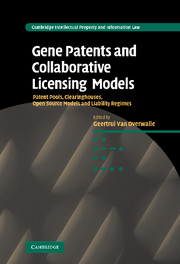 Gene Patents and Collaborative Licensing Models
Gene Patents and Collaborative Licensing Models from Part III - Open source models
Published online by Cambridge University Press: 14 January 2010
Introduction
The conceptual paper and case studies in this section evaluate possible extensions of the “open source”-style private ordering that has emerged in software to the life sciences. In evaluating such extensions, it is important initially to note the historical context in which open source emerged in software and the many flavors in which open source software currently comes. From this clarification of first principles, we can then imagine what open source in the life sciences might look like.
Background and clarification of principles
The concept of open source in software has its origins in the quasi-Mertonian ethic that prevailed among academic laboratories in the 1960s and 1970s. At the time, packaged software was relatively unusual, and labs regularly exchanged software and underlying source code for purposes of modification and improvement. The emergence of packaged software offered without underlying source code began to erode this Mertonian ethic. As Janet Hope points out, one response to such erosion was Richard Stallman's GPL license, which utilizes copyright licensing to mandate an expanding “commons” of source code. The GPL license not only sets up a situation where the source code commons can not be made proprietary, but by so doing it may create incentives to contribute in the first instance. A large percentage of open source software licenses continue to employ some version of Stallman's “copyleft” approach.
To save this book to your Kindle, first ensure [email protected] is added to your Approved Personal Document E-mail List under your Personal Document Settings on the Manage Your Content and Devices page of your Amazon account. Then enter the ‘name’ part of your Kindle email address below. Find out more about saving to your Kindle.
Note you can select to save to either the @free.kindle.com or @kindle.com variations. ‘@free.kindle.com’ emails are free but can only be saved to your device when it is connected to wi-fi. ‘@kindle.com’ emails can be delivered even when you are not connected to wi-fi, but note that service fees apply.
Find out more about the Kindle Personal Document Service.
To save content items to your account, please confirm that you agree to abide by our usage policies. If this is the first time you use this feature, you will be asked to authorise Cambridge Core to connect with your account. Find out more about saving content to Dropbox.
To save content items to your account, please confirm that you agree to abide by our usage policies. If this is the first time you use this feature, you will be asked to authorise Cambridge Core to connect with your account. Find out more about saving content to Google Drive.